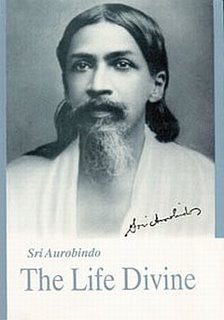 |
The Knot of Matter
Differentiated Unity
Sri Aurobindo reiterates the classical spiritual realization enshrined in the Vedas that proclaims the inherent Oneness underlying all existence as the fundamental Reality. He qualifies the oneness as a an "inalienable" and yet "manifold oneness" -"a differentiated unity".(The life Divine, pg.254) This oneness is discernible in three denouements;
(a) Firstly, an intrinsic oneness generating infinite variety is "the foundation and beginning". (Ibid, pg.256) In the fitness of things, it was this infinite variety that revealed the power and potentiality of the Oneness that gave birth to the multiplicity. In Vedic terms: "When universal being was concealed by fragmentation, then by the greatness of its energy That One was born".(Ibid, pg.255)
|
|
(b) Secondly, a constant reconciliation between apparent disparates is the hallmark of evolutionary emergence of forms. Thus Matter which is inert had to be reconciled with Life that is buoyant to produce animate matter. Sri Aurobindo explains that this reconciliation serving vast ends is the work of a "secret Consciousness and Will" (Ibid, pg.256) that is encrypted in the fundamental Oneness. In Vedic terms, "The seers of Truth discovered the building of being in non-being by will in the heart and by the thought".(Ibid, pg.255)
(c) Thirdly, the amalgam of Consciousness and Will -the Chit-Shakti that builds the multiverses from the basic Oneness must move towards its pre-programmed "triumphant harmony". (Ibid, pg.256) One must not doubt the inevitability of the divine decree and the inviolability of the Will that fashions the worlds. In Vedic terms: "there was self-law below, there was Will above". (Ibid,pg.255)
In fact, the Conscious-Will or Chit-Shakti that has built the world of multiplicity from a foundation of inalienable unity and fashioned forms from the formless must have its own intrinsic trajectory that extends from the Inconscience to the Superconscience. And as the whole phenomenon arises from an inalienable unity, it would not be surprising to visualize that one day, the Superconscient shall blossom in the Inconscient and Matter reveal the Spirit's face. With our limited minds and limited understanding, it is impossible to conceive that such a timeless phenomenon can be abruptly abandoned in midway. Teilhard de Chardin explains that claims of doomsday are irrelevant as a pessimistic view of the world fails to understand the "secret complicity between the infinite and the infinitesimal to warm, nourish and sustain to the very end-by dint of chance, contingencies and the exercise of free choice - the consciousness that that has emerged between the two. It is upon this complicity that we must depend."(Teilhard de Chardin: The Phenomenon of Man, Harper & Row, US, 1975, pg.275-276) Sri Aurobindo describes that it is Consciousness-Force which determines this complicity.
Substance
The Consciousness-Force that fashions the differential multiverses from the matrix of undifferentiated unity needs a medium through which it executes its preprogrammed trajectory. Sri Aurobindo explains that this medium is the Substance of which Matter is one end and the Spirit the other. He further clarifies, "The two are one: Spirit is the soul and reality of that which we sense as Matter; Matter is a form and body of that which we realise as Spirit." (The Life Divine, pg.256)
Substance therefore is "conscious existence" that has to be perceived differently at different planes in the "ever-ascending degrees of the world-existence" (Ibid):
(a) At the level of Matter, substance presents to the physical senses as an object.
(b) At the level of the Mind, substance is more subtle and needs to be perceived by inner or subliminal senses.
(c) At the level of pure dynamic Life-Energy, the inner senses can identify with the Pranic Energy which lies behind the "physically sensible force-currents".(Ibid)
(d) At the level of Spirit, substance becomes "pure", is no longer perceptible through senses as we know them but perceivable in a spiritual knowledge in which "subject becomes its own object" and the Timeless and Spaceless becomes "aware of itself in a spiritually self-conceptive self-extension as the basis and primal material of all existence".(Ibid)
(e) At the higher echelons of consciousness, there "is the disappearance of all conscious differentiation between subject and object in an absolute identity, and there we can no longer speak of Substance". (Ibid, pg.256-257)
Brahman throughout
It is the same Substance throughout the descending series of consciousness from Spirit through Mind to Matter and the ascending series from Matter through Mind to Spirit. The difference of the density of the Substance at different levels of the holarchy is not a mentally conceptive difference but a pure spiritually conceptive difference.(Ibid, pg.257) In the "original and integral view of things" (Ibid), the real oneness is never compromised, not even in the grosses densities characterizing Matter. And Brahman is not only the sole material of the Substance but simultaneously its cause and indwelling principle. Matter is just "a final form and objective aspect of the divine Existence". (Ibid) It is Brahman throughout.
Actually all the potentialities of the Substance are present at each level in consonance with the integrality of Brahman. Thus, within brute and inert Matter, the dynamism of Life is present as an instinct, a reason why even electrons know that they have to go on rotating. Within apparently unconscious Life lurks an "ever-working unapparent Mind" (Ibid) so that the bee knows how to build a bee-hive and the horse can be trained to race. Likewise, the ignorant and unillumined groping mind is "supported and sovereignly guided by its own real self" (Ibid), the creative Supermind so that one even unknowingly strives for perfection, yearns for the Infinite and craves for immortality. Supermind is present as a dormant principle everywhere, even in unmentalised Matter. All Matter "as well as all Life, Mind and Supermind are only modes of the Brahman, the Eternal, the Spirit, Sachchidananda, who not only dwells in them all, but is all these things though no one of them is His absolute being."(Ibid).
Date of Update:
17-Feb-20
- By Dr. Soumitra Basu
|

